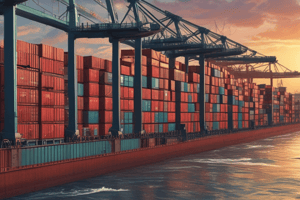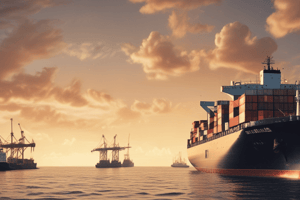Podcast
Questions and Answers
Liner Shipping involves scheduled services between predetermined ______ on a regular basis.
Liner Shipping involves scheduled services between predetermined ______ on a regular basis.
ports
The Cargo Liner Era involved multi-deck vessels carrying a mixture of cargo and ______.
The Cargo Liner Era involved multi-deck vessels carrying a mixture of cargo and ______.
passengers
The Container System replaced the Cargo Liner ______ in the 1960s.
The Container System replaced the Cargo Liner ______ in the 1960s.
system
The Bill of Lading is a key ______ in Liner Shipping, serving as a receipt, evidence of contract, and ______ of title.
The Bill of Lading is a key ______ in Liner Shipping, serving as a receipt, evidence of contract, and ______ of title.
Liner Shipping routes include East-West, North-South, and Intra-Regional ______.
Liner Shipping routes include East-West, North-South, and Intra-Regional ______.
Monopolistic Competition involves many producers and consumers with no business having total control over the market ______.
Monopolistic Competition involves many producers and consumers with no business having total control over the market ______.
The conference system was beneficial for the shipping industry but should be heavily ______.
The conference system was beneficial for the shipping industry but should be heavily ______.
Strategic alliances have been formed to improve efficiency and service ______.
Strategic alliances have been formed to improve efficiency and service ______.
The P3 Network was intended to make container liner shipping more efficient and improve service ______.
The P3 Network was intended to make container liner shipping more efficient and improve service ______.
The Ocean Alliance includes CMA CGM, China Cosco Shipping, Evergreen Line, and ______.
The Ocean Alliance includes CMA CGM, China Cosco Shipping, Evergreen Line, and ______.
G6 will lose APL and OOCL to Ocean Alliance, leaving it with Hapag-Lloyd, Hyundai, MOL, and ______.
G6 will lose APL and OOCL to Ocean Alliance, leaving it with Hapag-Lloyd, Hyundai, MOL, and ______.
Tramp owners respond quickly to supply/demand imbalances by moving their least efficient ships into ______.
Tramp owners respond quickly to supply/demand imbalances by moving their least efficient ships into ______.
Flashcards are hidden until you start studying
Study Notes
- The text discusses Liner Shipping and its characteristics.
- The Liner Service originated in the 1870s with improvements in steamship technology and the opening of the Suez Canal.
- The Cargo Liner Era involved multi-deck vessels carrying a mixture of cargo and passengers.
- The Container System replaced the Cargo Liner system in the 1960s.
- Liner Shipping involves scheduled services between predetermined ports on a regular basis.
- The service is designed for large numbers of small shipments between many shippers and receivers in multiple ports.
- The Bill of Lading is a key document in Liner Shipping, serving as a receipt, evidence of contract, and document of title.
- Liner Shipping routes include East-West, North-South, and Intra-Regional trades.
- Monopoly, Perfect Competition, Oligopoly, and Monopolistic Competition are discussed as market structures.
- Monopolistic Competition involves many producers and consumers with no business having total control over the market price.
- The supply of sea transport is influenced by freight rates.
- Tramp owners respond quickly to supply/demand imbalances by moving their least efficient ships into layup.
- Liner companies must stick with their schedules, making capacity inflexible.
- Marginal cost pricing can result in significant losses or profits.
- Liner companies agree to "fix" prices to stabilize rates.
- Liner pricing policy is based on price stability and price discrimination.
- Liner conferences coordinate and set shipping rates and related fees.
- The conference system was beneficial for the shipping industry but should be heavily regulated.
- Strategic alliances have been formed to improve efficiency and service quality.
- The P3 Network was intended to make container liner shipping more efficient and improve service quality.
- P3 was intended to be an operational, not commercial cooperation.
- Maersk, MSC, and CMA CGM signed an agreement to establish a network center in England and Wales.
- The P3 Network agreement became effective in the US in March 2014.
- The European Commission decided not to open an antitrust investigation into P3 in June 2014.
- MofCOM prohibited the P3 Network due to a high market share and entry barrier.
- P3 response to the decision is unknown.
- The Ocean Alliance was announced in April 2016.
- The Ocean Alliance includes CMA CGM, China Cosco Shipping, Evergreen Line, and OOCL.
- The creation of Ocean Alliance orphaned 8 container lines.
- G6 will lose APL and OOCL to Ocean Alliance, leaving it with Hapag-Lloyd, Hyundai, MOL, and NYK.
Studying That Suits You
Use AI to generate personalized quizzes and flashcards to suit your learning preferences.




